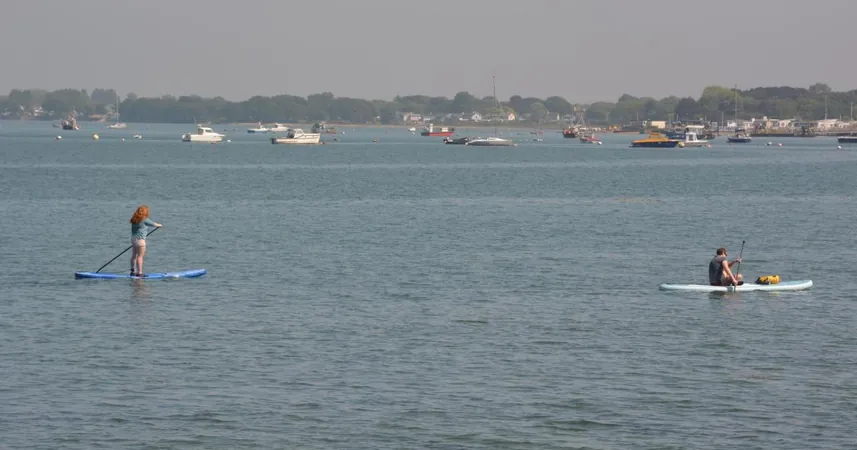
Alarming Surge in Harbour Chemicals Poses Threat to Wildlife – Experts Sound the Alarm!
2025-04-07
Author: Rajesh
Introduction
A recent study reveals a staggering 100-fold increase in harmful chemicals in the harbours bordering Hampshire and West Sussex following rainy weather, linking this surge to combined sewer overflows (CSOs). Conducted by a collaborative team from Brunel University, the University of Portsmouth, and Imperial College London, the research raises serious concerns for the local wildlife inhabiting the 21 Sites of Special Scientific Interest (SSSIs) in the region.
Key Findings
Dr. Thomas Miller from Brunel University emphasized the issue, stating, "CSO discharges serve as a clear source of chemical contamination in these waters. Our research shows that some chemicals spiked by more than 100 times after these discharges, posing a high risk to aquatic wildlife."
Published in the journal *Environment International*, the study analyzed 339 water samples, uncovering the alarming presence of 67 pharmaceuticals, 29 pesticides, and nine recreational drugs. This research comes on the heels of an alarming report from the Environment Agency, noting that storm overflows discharged sewage into England’s rivers, lakes, and coastal waters for an unprecedented 3.61 million hours in 2024.
Impact on Wildlife
Among the findings, researchers determined that seaweed absorbs more chemicals than shellfish, with the insecticide imidacloprid—commonly used in pet flea treatments—representing the highest risk due to its elevated levels in surface water. Dr. Leon Barron from Imperial College London expressed his concern: "The presence of pet tick and flea treatments in the harbours is particularly troubling. We urgently need to rethink the routine preventive treatments given to our pets to mitigate these risks."
The study also detected 1,3-diphenylguanidine, a compound used in rubber production, potentially signaling pollution from wear-and-tear particles from vehicles and road runoff after rainfall. The lead author, PhD student Jasmin Uhlhorn, stated, "Our findings reveal the complexity of chemical mixtures occurring in coastal and transitional waters, necessitating more thorough monitoring to uncover their sources, including the impacts of CSO discharges."
Concerns Raised by Experts
Professor Alex Ford from the University of Portsmouth’s Institute of Marine Sciences underscored the extensive impact of these contaminants: "Though we haven't fully grasped their effects, our data indicates that these chemical levels increase significantly during storm events, when untreated sewage is released."
Rob Bailey, co-founder of the Clean Harbours Partnership, voiced his concern over the unsettling cocktail of detected chemicals: "It is alarming to see such a variety of chemicals in our waters, with their effects largely unknown. As a community-based organization, we are committed to advocating for improved monitoring of these vital marine habitats."
Call to Action
The urgency of addressing chemical pollution in these environments cannot be overstated. With increasing rainfall and overflows becoming more common, local wildlife is facing unprecedented risks. Experts are calling for immediate action and stricter regulations to safeguard both the environment and the communities relying on these vital ecosystems. Stay tuned as this story develops—our wildlife depends on it!




 Brasil (PT)
Brasil (PT)
 Canada (EN)
Canada (EN)
 Chile (ES)
Chile (ES)
 Česko (CS)
Česko (CS)
 대한민국 (KO)
대한민국 (KO)
 España (ES)
España (ES)
 France (FR)
France (FR)
 Hong Kong (EN)
Hong Kong (EN)
 Italia (IT)
Italia (IT)
 日本 (JA)
日本 (JA)
 Magyarország (HU)
Magyarország (HU)
 Norge (NO)
Norge (NO)
 Polska (PL)
Polska (PL)
 Schweiz (DE)
Schweiz (DE)
 Singapore (EN)
Singapore (EN)
 Sverige (SV)
Sverige (SV)
 Suomi (FI)
Suomi (FI)
 Türkiye (TR)
Türkiye (TR)
 الإمارات العربية المتحدة (AR)
الإمارات العربية المتحدة (AR)